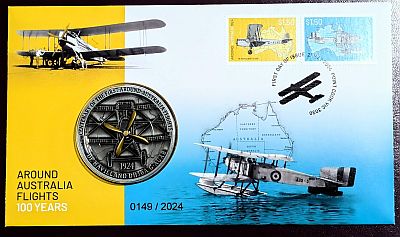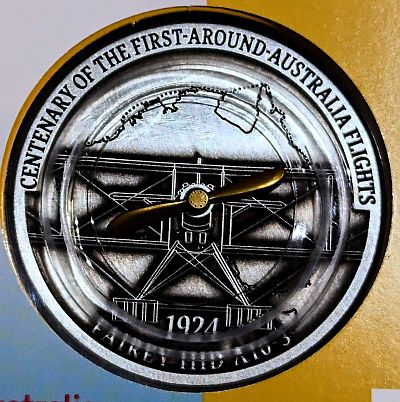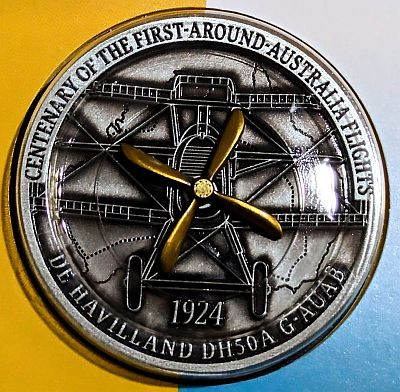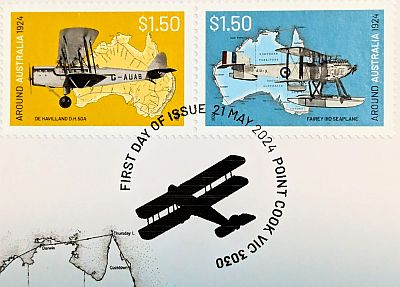A medallion with spinning propellors

Cover
This Postal Medallion Cover (PMC) from Australia Post commemorates the centenary of the first two flights to circumnavigate Australia. The piece uses a four-colour palette:
- Cerulean blue behind the military seaplane
- Gold, canary yellow behind the civilian landplane
- Black for details
- White / light grey for highlights
The colour theme works really well and contrasts the two events nicely with each other.
The reverse has details of the flights on a light blue to white gradient. Details below are from both the PMC itself, and the Australia Post Collectibles site.
Fairey IIID seaplane A10-3

The medallion features the front of one plane per side. The reverse features the first plane to circumnavigate Australia, the Fairey IIID seaplane A10-3. The two-bladed propellor in brass turns freely on the medallion. The clear plastic housing the medallion is open in the centre so the propellor can be turned.
The first flight began on 6 April 1924, when Wing Commander Stanley Goble and Flying Officer Ivor McIntyre set off from the RAAF base at Point Cook, Victoria, in a single-engine, open-cockpit, Fairey IIID seaplane, A10-3. The duo travelled anti-clockwise, via Sydney, Southport, Townsville, Thursday Island, across the Gulf of Carpentaria to Darwin, Broome, Carnarvon, Perth, Albany, and Port Lincoln and back to Victoria. They battled poor weather and constant engine trouble and in Carnarvon, Western Australia, the plane’s engine had to be replaced. On 19 May, after 44 days and 13,600 kilometres, they alighted at St Kilda beach, Victoria, to an enthusiastic welcome from a 10,000-strong crowd gathered on the Esplanade.
De Havilland D.H.50 G-AUAB

The obverse of the medallion features the De Havilland D.H.50 G-AUAB. The four-bladed propellor spins freely (connected with the propellor of the Fairey III).
The second round-Australia flight, this time in a landplane, was carried out three months later by the Civil Aviation Branch (CAB) of the Department of Defence to inspect air routes and to test the long-distance efficiency of the De Havilland D.H.50 aircraft. The crew of the aircraft, registered G-AUAB, comprised expedition leader and Controller of Civil Aviation, Lt Col HC Brinsmead; pilot Captain EJ Jones, the CAB’s Superintendent of Flying Operations and Personnel; and mechanic RH Buchanan, an assistant Superintendent of Engineering. After departing Point Cook on 7 August, the trip was undertaken in three stages: Melbourne to Darwin via Bourke, Longreach and Cloncurry; Darwin to Perth; and Perth back to Point Cook, where they alighted on 29 August after flying 12,324 kilometres.
Medallion specifications
- Minimum gross weight (g): 41
- Maximum diameter (mm): 48
- Maximum thickness (mm): 4.0
- Metal component: Zinc alloy
- Finish: Antique silver and antique gold
Stamps

The blue stamp design is based on a photograph by Stan Copplestone, 1930, Fairey III D Seaplane A10-3, Hilda Copplestone Collection, Library & Archives NT, PH0457/0018.
The yellow stamp design is based on a photograph of the De Havilland D.H.50A from the Stephen Barnham collection.
The first day of issue was 21st May 2024, and the cancellation mark is Point Cook, Vic 3030. Point Cook is still the site of an RAAF base.
RAAF Base Point Cook is the birthplace of the Australian Flying Corps and the Royal Australian Air Force. The base covers 341 ha and is located approximately 26 km from Melbourne CBD and 8 km south of RAAF Williams.
The RAAF Museum is currently the largest Defence unit at Point Cook. It features the oldest and most extensive complex of military aviation buildings. RAAF Base Point Cook was included in the National Heritage List on 29 August 2007.


Leave a Reply